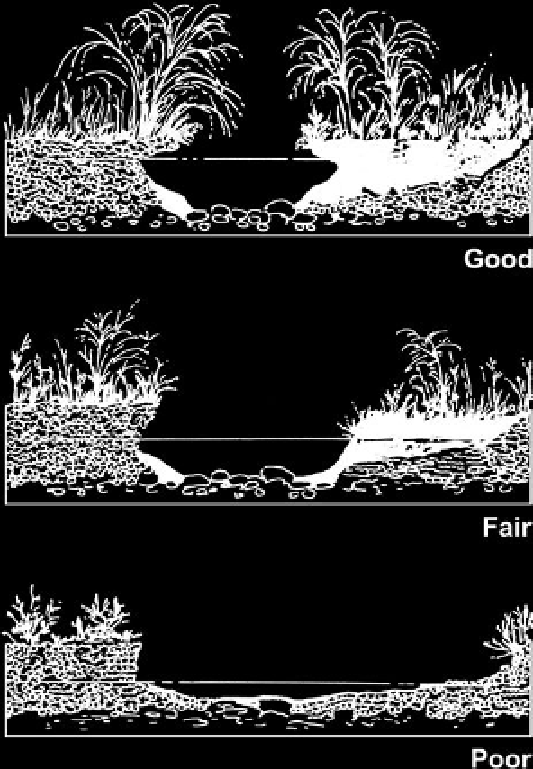Geoscience Reference
In-Depth Information
about 85 percent of the streamflow in Wyoming still
struction has been stalled by economic constraints,
environmental concerns, and binding agreements
with downstream states. the most direct negative
effects of reservoir construction are the loss through
inundation of a free-flowing stream and its associated
riparian habitat. Sacrifices are always necessary and
must be weighed against the obvious benefits.
one reason reservoirs are controversial is that their
utility can be short-lived because of sedimentation,
which continues regardless of location. Sedimenta-
tion frequently is accelerated by human activities that
increase erosion. Dealing with large, sediment-laden
reservoirs will be a problem for future generations. Bea-
ver also cause sedimentation, but their activities are
restricted to small areas; the breaking of a beaver dam
is not a big issue.
the various purposes of reservoirs include flood con-
trol, irrigation, power generation, and recreation. typi-
cally, water levels fluctuate considerably—high at the
beginning of the growing season to maximize the water
available for agriculture later in the summer, but low by
the end of the growing season because of withdrawals
for irrigation. Reservoirs with hydroelectric plants, such
as those on the north Platte River, may have water
level drawdowns at times of high demand for electric-
ity. When water levels are down, nearly barren shores
are created that sometimes become saline mudflats and
sources of dust clouds. Most native plants cannot tol-
erate the water-level fluctuations that occur, although
such sites can become dominated by weedy species capa-
ble of rapid growth, such as dock, foxtail barley, goose-
foot, knotweed, saltcedar, sowthistle, summercypress,
sumpweed, and sweetclover. in general, sedimentation,
water-level fluctuations, and the streamflow changes
associated with reservoirs inevitably disrupt the ripar-
ian ecosystem. the seriousness of these changes must
be judged after considering what is lost, what is gained,
and how long the benefits are likely to last.
Flood control levees also disrupt riparian land-
scapes. the most prominent example in Wyoming is
in Jackson Hole, where in 1957 the U.S. Army corps of
engineers and other entities began channelizing the
Snake River to protect valuable private property from
Fig. 4.15. excessive grazing and trampling by large animals
can convert cool, narrow creeks with overhanging banks
to warm, shallow creeks that are less suitable for fish. Also,
the sediments (black) that contribute to bank storage and
late summer flows are lost. Streams in poor condition can be
restored.
ter ranges were much lower, due to predation by wolves
on willows, juniper, and aspen are now commonly
observed throughout the region, sometimes the result
Whether such browse lines are an indicator of excess
grazing is debatable (see fig. 10.16).
Reservoir Construction and Management
Because of the state's high elevation, Wyoming is part
of an area known as the headwaters of the West. Snow-
fed streams flow into all major drainages (see fig. 4.1).
there are 116 reservoirs with storage of 1,000 acre-
feet or more that retain some of this water for irriga-

Search WWH ::

Custom Search